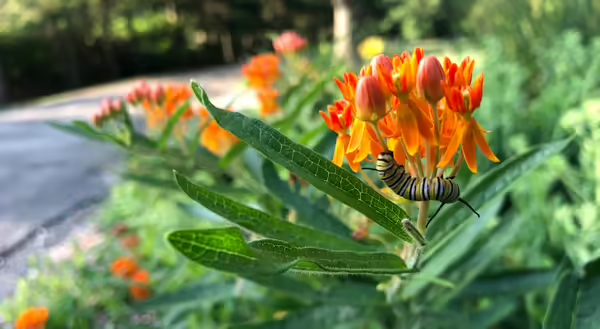
Among gardeners, there is an ever-growing interest in creating plant arrangements that support pollinators. This has been driven by recent research identifying declining insect populations around the globe as gardeners respond with garden design to provide valuable habitat. In addition, pollinator gardens are typically focused on providing the maximum amount of flower display, which is a key food for pollinators and key aspect of garden beauty.
Monarchs and Milkweeds
The monarch butterfly may be the poster child for pollinator decline, given the wide range of research documenting the species’ plight. This charismatic, migratory species’ lifestyle has captured the attention of gardeners and has taught us an important lesson on pollinator support.
While a season of beautiful blooms is certainly the focus of many pollinator garden efforts, support of larval stages (caterpillars) has largely been overlooked. The monarch’s exclusive relationship with milkweed species (Asclepias spp.) is well known. Simply put, monarch caterpillars must have milkweed to feed on and, thus monarch butterflies cannot exist without milkweed.
Declining milkweed populations are one huge factor in dwindling monarch populations over time. Knowing this, gardeners have sought out milkweeds to include in pollinator gardens and the horticulture industry has responded in-kind. Its now relatively easy to find milkweed plants in most garden centers.
However, some question remains as to whether or not the plants we find in garden centers are the best for monarchs or other pollinators. Most research has indicated that native species are the most supportive to native pollinators, yet the majority of plants for sale each year are non-native and even among the plants labeled as “native” there is a question to their value.
Are cultivars effective?
For whatever reasons, the horticulture industry is not satisfied with simply providing gardeners with native species. Commercial production has focused on the development of new cultivated varieties (cultivars) or hybrids, that typically boast improved characteristics over the regular old, native variety, commonly called the “straight-species”.
While some of these horticultural efforts have truly solved performance issues in the garden, such as Monarda cultivars that show increased resistance to powdery mildew, many plant experts question the value of these cultivated varieties for pollinators.
A 2020 research paper did provide some interesting answers to some of these questions with respect to milkweed plants. Researchers at the University of Kentucky and Michigan State compared native milkweed species to their cultivars to assess the value for both monarchs and bees in urban gardens.
This paper compared the native swamp milkweed (Asclepias incarnata) and orange butterflyweed (Asclepias tuberosa) to three cultivars of each species. The swamp milkweed cultivars assessed included: Asclepias incarnata ‘Cinderella’, ‘Ice Ballot’ and ‘Soulmate’. Among the butterfly weed cultivars were: Asclepias tuberose ‘Blonde Bombshell’, ‘Gay Butterflies’ and ‘Hello Yellow’.
Researchers monitored the milkweed plants for monarch egg laying and the presence of caterpillars. They also monitored flowers for bee use by collecting and identifying bees found on flowers. Results indicated that cultivars attracted very similar numbers of insects when compared to the straight-species. One significant difference the study did reveal is that monarchs preferred swamp milkweed and its cultivars over butterflyweed.
The horticulture industry faces a challenge in providing ecologically important plants which are both attractive and profitable to grow. It’s great to see that native cultivars of these milkweed species provide similar ecological support as the straight-species. However, other research has uncovered significant differences when comparing cultivars. In addition, research on this topic is relatively sparse, so there is certainly a need for more studies of this kind.
In recent years, I’ve begun to see more research in this area, which is encouraging. I am hopeful that research can increase, and growers can follow the facts so that ornamental plants we find in garden centers can also be the ecologically supportive habitat elements our native pollinators need so desperately right now.
Photo Credit: Candice Anderson, Illinois Extension
Photo Caption: This monarch caterpillar feeds on orange butterflyweed, which is one of our native milkweed species that serve as the exclusive host plants for monarchs.